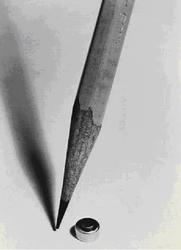 Reasearchers at the Center for Integrated Nanotechnologies (CINT) claim to have created the tiniest battery in the world.The rechargeable , lithium-based battery was developed by a team led by researcher Jianyu Huang. The battery comprises a 3mm long lithium cobalt cathode, a single tin-oxide nanowire anode and an ionic liquid electrolyte.The anode , which measures 10 nanometres in length and 100 nm in diameter, is one seventhousandth the thickness of a human hair. A lithium-ion battery with nanowire-based materials greatly increases the power and energy density compared to one using bulky electrodes.
Reasearchers at the Center for Integrated Nanotechnologies (CINT) claim to have created the tiniest battery in the world.The rechargeable , lithium-based battery was developed by a team led by researcher Jianyu Huang. The battery comprises a 3mm long lithium cobalt cathode, a single tin-oxide nanowire anode and an ionic liquid electrolyte.The anode , which measures 10 nanometres in length and 100 nm in diameter, is one seventhousandth the thickness of a human hair. A lithium-ion battery with nanowire-based materials greatly increases the power and energy density compared to one using bulky electrodes.Researchers developed this battery in order to better understand the mechanism in which it works and formed the battery inside a transmission electron microscope that would enable them to study charging and discharging of the battery in real time and at atomic-scale resolution
According to the VP and General Manager of EaglePicher Medical Power, the battery performance is truly a revolution when compared to anything that is currently available on the market, making the possibility of smaller implantable medical devices a reality. There is no word on how much these batteries will cost, but they certainly won’t come cheap.The researchers found that while charging, the tin-oxide nanowire rod almost doubled in length. This was greater than the diameter increase and could result in avoiding short circuits that often reduce battery life. The CINT is a department of Energy research facility jointly operated by Sandia and Los Alamos national laboratories


 5:37 AM
5:37 AM
 Unknown
Unknown

 Posted in:
Posted in: 












0 comments:
Post a Comment